The Sprocket Rocket is a plastic, panoramic 35mm camera that offers a 1:3 aspect ratio. The lens is a 30mm with f/10.8 and f/16 settings, and a fixed mechanical shutter with a speed of 1/100, or a bulb setting which I have never used. That would involve bringing a tripod which doesn’t suit my style.
Every shutter press exposes the width of two frames, so a traditional 36 exposure role of film will give you 18 wide angle images. The camera does not require any batteries.
I happened onto a Sprocket Rocket as an impulse buy: I won a 50/50 contest for $150 while working my wife’s booth at a farmer’s market, then, flush with money, I walked into the Art supplies shop across from the market which had a selection of lomography cameras for sale. In my mind, since I just won the money, blowing it on a camera of the same price meant I really just won a camera. The camera sold for a little over $100 new.
The photos here were taken at one of those seedy fairs/carnivals that travels from town to town in late summer. I love the atmosphere at these fairs – the blasting of early 80s rock ballads, the siren-call of hoarse-throated carnies trying to entice you into trying your luck and some unwinnable game, the corn dogs on a stick. Expired lomography 400 colour film was used (and when I say expired I mean the film sat in a plastic bag in sunlight for about a year).
The Sprocket Rocket is the perfect camera for carnivals. The wide angle captures the essence of the crowds, the rides, the carny games. The rugged casing and lack of delicate parts means if you drop it from a ferris wheel and it bounces a couple of times off the pavement, no problem. Since it has no electronics or delicate parts, you could dunk it in a lake, dry it off, and it would not be worse for wear.
The Sprocket Rocket does expose the sprocket holes, so that your image will be shown in the area where the sprockets are. Unfortunately, I do not have the proper gear to scan an image with the sprocket holes, and that part gets cropped out as part of the scanning process.
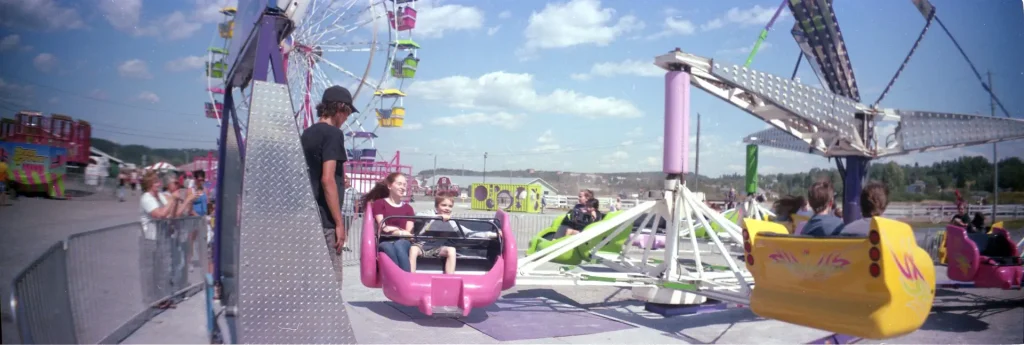
When I go to the fair, I bring about $80, with the intent to lose it all. I play all the games, go for the big prizes. I enjoy it when the carnies yell at you in that throaty, hoarse voice “hey big fella, ya look like you got a strong arm” . I’m all in….I stride right up, throw my three balls at the unhittable target, revelling in the challenge.
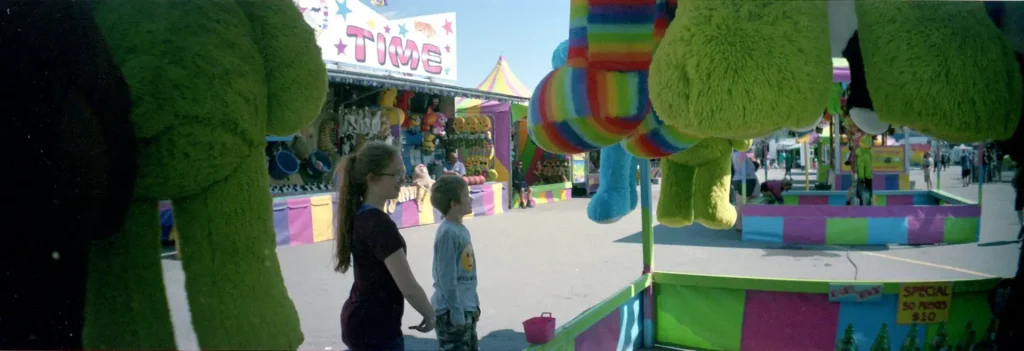
Sometimes it’s fun to take photos without an exposure metre. If the photo of my kids playing a water gun racing had been taken with a modern camera, it would have exposed either for the dark shadows, blowing out the bright-sun lit areas, or it would have exposed for the lighted areas, blacking out the game. The fixed exposure of the Sprocket Rocket gives the whole picture, as my eyes saw it.

Because it is a fixed exposure, you can take shots directly into the sun without the exposure meter turning everything into silhouettes.
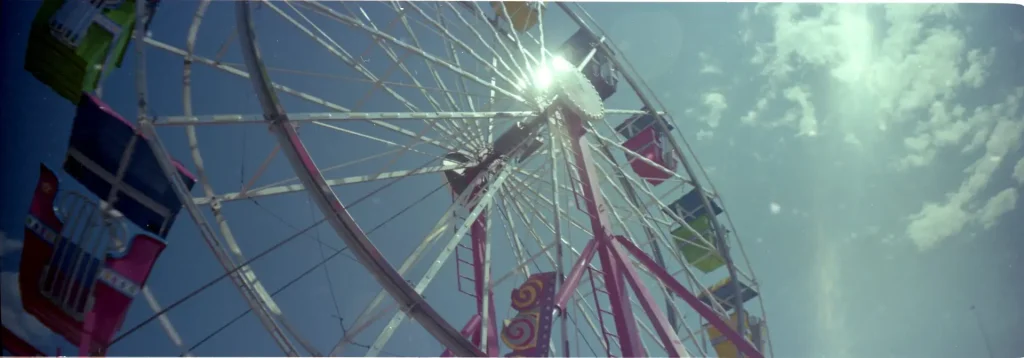
With the sunny-16 rule, at f/16 and a shutter of 1/100, my film iso should have been 100 – but 400 is what I had, so the photos are over exposed by a stop or two. But I like the effect.
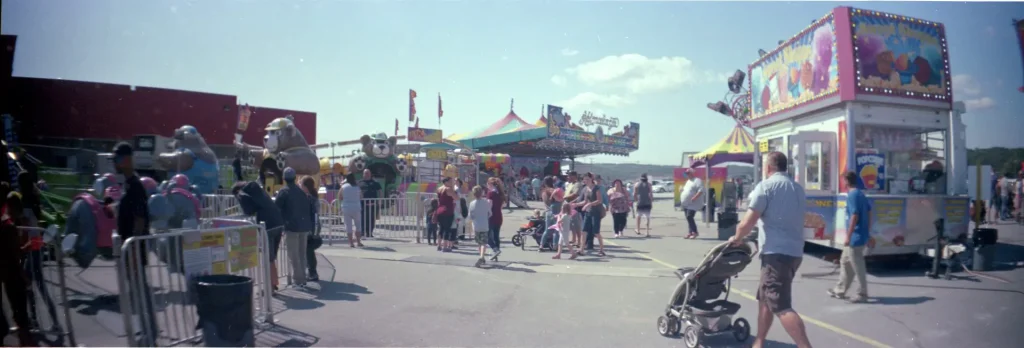
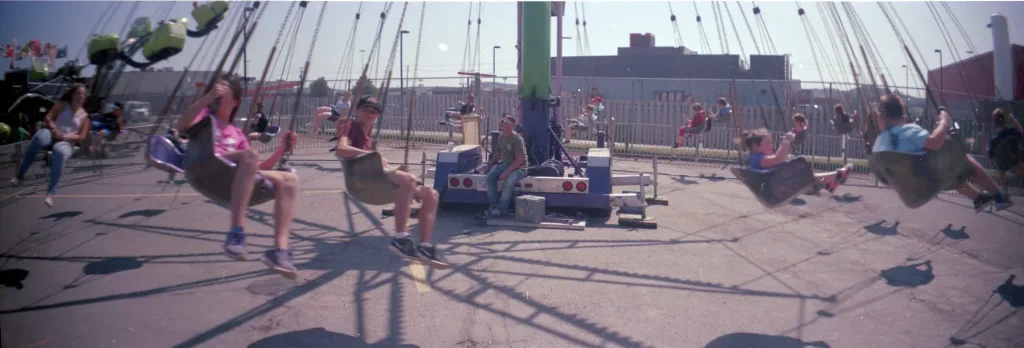
An interesting aspect of the Sprocket Rocket is the film advance is completely manual, which you can use to creative effect. The picture below combines a street scene with a beach scene because I deliberately did not fully advance the film. This also makes double exposures easy – just don’t advance the film.

One issue I had with the Sprocket Rocket is that I sometimes unintentionally didn’t advance the film properly, which led to some images bleeding into other images, as you can see on the left hand side of the photo below. Not a big issue and can be fixed by cropping.

There are two minor ergonomic flaws with the Sprocket Rocket that I do find annoying:
1) The shutter speed lever, which toggles between 1/100 or bulb, easily slips into bulb mode, which can lead to shaky photos if it accidentally slips to bulb.
2) In order to line up the negative for the next image, you have to turn a black knob until you see a white spot appear in a small black hole. If you have bad eyesight like me, under bright conditions it can be difficult to advance the film properly.
One difficulty in using the Sprocket Rocket, which is not really the fault of the camera but the panoramic format, is getting the negatives scanned or printed, because the images are basically two frames exposed together, resulting in a 70mm x 24mm image instead of the traditional 35mm x 24mm image.
The enclose photos are as-scanned, without further editing. I found that a little boosting of the colours and reducing the exposures improved the shots, but I felt for this article I wanted to stay as true to the camera/film combination as possible.
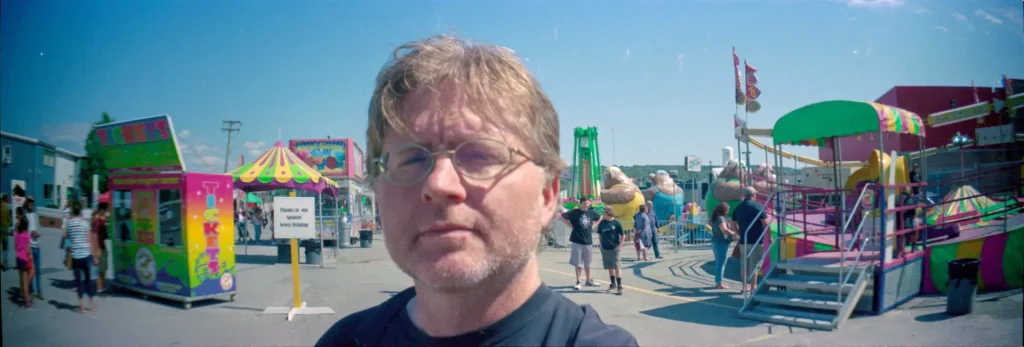
In summary I generally enjoyed the Sprocket Rocket. It’s rugged, easy to use, doesn’t need a battery or anything, and it lets me take super wide pictures. If I feel real sassy it even let’s me expose the sprockets on the negatives. For about $100 CDN it let’s me take pictures none of my other cameras will.
Alex Vye
https://swanstationadmin.wixsite.com/3d6ix/post/4-frames-in-fundy-park
https://swanstationadmin.wixsite.com/3d6ix/post/4-frames-in-irishtown-park-during-pandemic
Share this post:









Comments
Ben Garcia on Sprocket Rocket 2.0 Review – A Day at the Fair – By Alex Vye
Comment posted: 11/08/2020
Comment posted: 11/08/2020
MrSnappy on Sprocket Rocket 2.0 Review – A Day at the Fair – By Alex Vye
Comment posted: 11/08/2020
Comment posted: 11/08/2020
Aivaras on Sprocket Rocket 2.0 Review – A Day at the Fair – By Alex Vye
Comment posted: 12/08/2020
Comment posted: 12/08/2020
Scott Gitlin on Sprocket Rocket 2.0 Review – A Day at the Fair – By Alex Vye
Comment posted: 13/08/2020